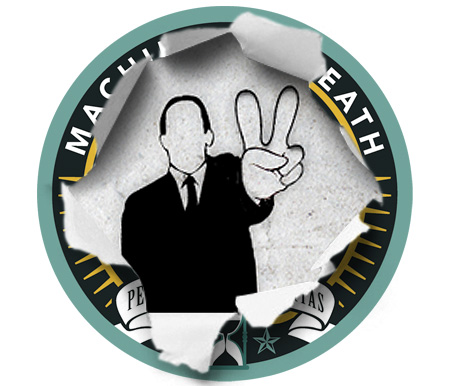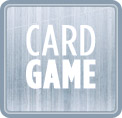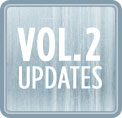Vol2 Updates 26 Apr 2011 10:20 pm by David !
MOD Volume 2 Submission Guidelines
We’re doing it again! We’re putting out a second volume of Machine of Death, and if you’re a writer or an artist then this is your chance to be involved.
Skip to: How to submit a story • What we’re looking for • Approaches to avoid • How to submit an art portfolio

If you’re interested in submitting a story or an art portfolio, we strongly recommend you take a look at our first book to get an idea of what kind of stuff we’re looking for. The book is available in tons of places (if you live in the U.S. or Canada, check your local bookstore!) and there’s even a free PDF if you can’t get it any other place. So go ahead and give it a look! We’ll be here when you get back.
Open Submissions for Writers
Anybody can submit a story to Machine of Death, and we mean anybody. There are only two eligibility requirements: any story you submit must be written in English, and you (or a legal guardian, if you’re a minor) must be willing and able to sign a contract if the story is accepted. That’s it!
Our first book featured stories written by people who had never been published before, and people who make their living writing. There were stories by video game reviewers, lexicographers, comedians, poets, cartoonists, college students, and plenty of folks with totally square day jobs. Our writers were living in North America, Europe, Asia, South America, and Australia. (Africa and Antarctica — show us what you got!) We love this diversity; we think different viewpoints, different life experiences, and different writing styles make for a unique and awesome book. So yes, absolutely anybody can submit a story — including you!
This first section is about the technical details of how to submit. For more detailed information on what we’re looking for and what we’re not, go here. For artist guidelines, go here.

SUBMISSION PERIOD
Submissions will be accepted from May 1 – July 15, 2011. We expect to make our final selections by October 31, 2011.
PAYMENT
We pay $200 (US) upon acceptance.
LENGTH
Stories can be any length, but we recommend a length of 1,500 – 7,500 words. We will almost certainly be printing stories longer or shorter than these limits, but we expect most stories in the book will fall into this range.
RIGHTS
We buy the following rights:
• World anthology rights in English and translation
• Audio and ebook anthology rights
• Film rights, with an additional bonus payout of $4,000 if your story is substantially used in any commercial movie or TV adaptation of Machine of Death
World anthology rights and audio/ebook anthology rights are specific to anthologies. These are non-exclusive licenses allowing us to use your story in an anthology only. Specifying “in translation” allows us to request that your work be included in any potential foreign editions as well.
You retain all other print rights. So you’re free to also sell your story to magazines, or websites, or podcasts, or as an individual short story (say, on Kindle), or in a collection of your own work, or even sell it to another anthology after our book has been out for a while. It’s your story, and you keep it — we just want to be the first to print it.
Film rights allow us to include your story in any conversations we have about adapting the general Machine of Death concept into a film or TV show. Buying the rights upfront means that if any producer is interested in an MoD movie, we can instantly say “Yes! Make it happen!” without unresolved rights issues scaring anybody off. (Plenty of movies don’t get made for lesser reasons.) We don’t know if there will ever be an MoD movie or show, but we’d love for there to be! And having the rights ready just in case increases the odds that it could actually happen.
Additionally, we expect to release a Creative Commons edition of the next book, just as we did with the first one. Most of the authors in the first book elected to release their stories under Creative Commons, but it’s not strictly required. If you have strong feeling about this either way, please let us know upfront so we can take it into account when reading your story.
FORMATTING
We only accept email submissions. You can either paste your story into the body of your email message or send an attachment. If you are attaching, please use Microsoft Word (DOC), Rich Text Format (RTF), or Plain Text (TXT) formats only. Any word processor should be able to save a file as at least one of those formats. We’re not sticklers for things like double-spacing and paragraph indentation and point size. Just submit a file that is as readable as possible.
HOW TO SUBMIT
Send your story to submit at machineofdeath dot net. Please use the following subject line when submitting…
[MOD2] STORY TITLE – Your Name
So if your name is Sherwood Anderson and if your story is called “SWALLOWING A TOOTHPICK” then the subject line of your email should read…
[MOD2] SWALLOWING A TOOTHPICK – Sherwood Anderson
This is in case we get two stories with the same title, so we can tell which one is yours. Please follow this format, so your submission does not get overlooked!
Next, in the body of your email, please include the following information…
• Title: The title of your story
• Pen name: How you would want your name to appear in print
• Word count: Approximately how many words are in your story
• Real name: Your real name (not a pseudonym or handle — this is the name that will go on the contract)
• Email address
• Phone number
• Short biography: This is optional, but we’d be happy to read a short paragraph or two about your previous writing experience, where you’re from, or any personal information that has a bearing on your story. No other cover letter is necessary.
All of this information is REQUIRED (except the short biography). Don’t ask us if you can omit one or more pieces of information because the answer is “NO”. However, we won’t share any of your personal information with ANYBODY, and we will only use your contact information to tell you whether your story was accepted, and then once to tell you when the book is finished. We will always try to contact you via email first — the phone number will only be used if we need to get in touch with you and email isn’t working.
If your story is accepted we’ll ask you to confirm all your information, and you’ll also have the chance at that time to write a new short biography for publication in the book.
Finally, we ask that each writer submit no more than 3 stories. Please send only previously unpublished work, and no simultaneous submissions. Otherwise, have fun! We can’t wait to read all your stories!
A special note to those who submitted to Volume 1
If you submitted a story to the first book, we would love to have you submit again to the second volume! However, in most cases we ask that you do NOT send the same story you sent the first time. We still have all the old stories on file, as well as our notes on them. There are a couple that we’ll be considering for inclusion in the second book, but for the most part we are looking for ALL NEW stories.
The only exception to this is if you have substantially changed your story since the last time you submitted. And I mean really really changed it. I don’t just mean you’ve gone through and cleaned up some grammar or cut out some unnecessary sentences. I mean if you’ve added, subtracted, or completely rewritten whole sections of your story. Here’s a good rule of thumb: If you have the same characters facing the same conflicts and ending the same way, then your story probably hasn’t changed enough.
But we would love to see something new from you!
Authors whom we published in Volume 1 are welcome to submit new material, but no preferential treatment will be given. You’ll just have to be exactly as good as before.

The Kinds of Stories We’re Looking For
Machine of Death is an anthology of short stories with a shared premise. (If you haven’t looked at our first book yet, go ahead and do that now.) All stories in the book start with the idea of a machine that can use a blood test to tell you how you’re going to die — sometimes vaguely, but always accurately. The introduction to the first book contains a great encapsulation of the premise. Read it here.
What are we looking for in a story? All kinds of stuff! There’s not one particular type of story we’d like to see, but there are some general guidelines we can share. Here are some things we like:
• Characters we like spending time with. Your characters don’t have to be nice or likable all the time, but there should be something about them that makes a reader want to spend time with them.
• Diverse settings, viewpoints, and voices. We don’t want a book where every story is about the same kind of people. We want a book that explores every corner of the world! We’ve all read Volume 1, and don’t need more of the same; instead, show us something we didn’t see there.
• The kind of details that come with experience. Stories don’t need to be based on real life, but we love it when writers are able to add details from their own experiences and observations. We like learning new things from people who have been there.
• A central, compelling idea or conflict. We like stories where things happen, where characters change and grow, or where exciting ideas are shared. We want stories that can stand on their own feet, and don’t rely entirely on the death prediction premise for their oomph.
• A dash of life. This is a book about death, but we definitely don’t want it to be grim and dour all the time. We like stories that have a dash (or more!) of life in them — humor, adventure, love, excitement, big ideas, and keen observations.
Some other important things to keep in mind as you are thinking about your story:
• The stories in the book have a shared premise, but they don’t belong to a shared universe. Details can change from story to story, including how the machine works, how it was invented, who uses it, how the world reacts to it, and so on. If we wanted to have a shared universe, we’d need to make up a huge list of thousands of details that every story must agree on. That sounds boring, and frankly we think the stories are better when writers can be as creative as they want.
• You can assume that a person reading your story will already be very familiar with the premise of the book. You are welcome to provide your own creative explanations and descriptions of the machine if you like — but don’t feel like you have to explain the premise. You can just refer to the machine like you would any other piece of technology that people take for granted. You can even name it whatever you like! It doesn’t have to be called “the Machine of Death”.
• There are a few things that do need to be consistent among the stories. The death predictions in your story MUST always be accurate, they MUST always be the same for each individual, and they MUST be derived from a blood test. Those are the most important elements of the premise — beyond that, you are welcome to experiment with different permutations of everything else. The setting does not have to be contemporary; the machine does not have to be either new or old; the world can be either speculative or familiar, etc.
• Your story MUST prominently feature either the machine or its death predictions. It can’t just be mentioned in passing — it has to play a role of some significance. However, your story does not need to include people getting their predictions, or predictions coming true, or any other particular scene related to the machine. It’s boring if all the stories have the same scenes, so how you use the machine and its predictions is totally up to you!
• Many readers and reviewers loved the first Machine of Death book. We think a big part of its success is its diversity, so we welcome stories in all genres, all styles, all settings, and all tones. Write the very best story that you know how to write, and do your best to surprise us with a new take on the premise!
• Finally, the title of your story MUST be a death prediction. It doesn’t need to be any particular character’s death and it certainly doesn’t have to actually happen in your story. It could even be a hypothetical death that’s discussed by people in your story. Take a look at the stories in the first book for some ideas on how you can name your story without giving away important plot details.

(Updated with even more info here!)
We think the premise to the Machine of Death is really open-ended and that it allows for plenty of different kinds of stories. We received almost 700 submissions to the first book, and just when we thought we’d seen it all, we’d get a new and totally original story. This is exactly what we hope for, and it’s this promise of new ideas that makes us want to do a sequel.
However, the premise often does point people down a few well-worn trails, so we also saw some ideas come up again and again. The list that follows includes some of the most common kinds of stories we get. This doesn’t mean that stories with these plots are bad or that we’ll refuse to put them in the book. But since we like to be surprised, we’d love to have more people direct their creativity in other directions too.
• The Ironic Death Prediction: A person gets a death prediction that seems straightforward and they expend a great deal of energy avoiding whatever it is that’s supposed to kill them. But alas, at the end of the story they are felled by some alternate reading of the prediction that they hadn’t accounted for (e.g., “RAZOR” turns out to be a Razor scooter rather than a razor blade). Our verdict: The ironic joke at the end will have to be REALLY FUNNY for this to impress us.
•The First Time I Got Tested: The story is about a person deciding whether to get tested, or preparing to get tested, or explaining why they would or wouldn’t get tested. Our verdict: We published a few of these in the first book, and yours would have to do something significantly different to be seriously considered. In general, you’ll have a much better shot if there’s more to your story than this!
• Obsessed with Living Forever: A person gets their death prediction and then spends the rest of their life ensuring that they will never come in contact with whatever is supposed to kill them. (Only to be killed anyway in the end — usually ironically.) Our verdict: People might make small lifestyle changes in response to their predictions, but the guy who moves to the middle of the Sahara to escape “TRAIN DERAILMENT” would only exist if your story is a fairy tale or a parable.
• Obsessed with Proving Destiny Wrong: A person tries to “prove the machine wrong” by killing themselves or other people, but of course their plans go awry. Our verdict: This is a crazy thing for a person to do, and your story would have to be REALLY CLEVER to impress us. We also covered some of this ground in the first book already, and now we’re interested in different types of stories.
• The One-Two Punch: A person gets tested, and the prediction comes true almost immediately. Our verdict: We like stories that have something new and interesting to say — it’s hard to do that if Scene 1 of your story is a character getting a prediction, and Scene 2 is them dying.
• The Machine Did It: A person gets tested and discovers that the test itself is the cause of their death (e.g., “PAPER CUT”, “NEEDLE INFECTION” or “CRUSHED BY MACHINE”). Our verdict: We published one of these in the first book. We are not likely to publish the same joke twice.
• The Otherwise Ordinary Serial Killer/Terrorist: An otherwise perfectly normal person is somehow driven by the existence of death predictions to become a serial killer (usually in order to make predictions come true) or a terrorist (usually in order to destroy the machine). Our verdict: You would probably have to be the world’s greatest writer to make this kind of transformation believable. Serial killers are especially overexposed in movies and books today, so once again we’d love to see more stories about other things.
• The Suicide: There’s not a particular storyline to this one, but we get A LOT of stories about people who find out that their cause of death will be “SUICIDE”. Our verdict: It’s hard to stand out in such a crowded field, so we urge you to try something else.
• The Last Movie That You Saw: A story closely mimics the plot, setting, or characters of a popular movie, book, or television show — except with the addition of death predictions. Our verdict: We’re looking for original stories from your imagination, not “Machine of Death Meets Inception” or “Machine of Death Meets Avatar”. Every blockbuster creative work spawns legions of imitators, and if your work is heavily inspired by Harry Potter then it’s going to be hard to stand out.
• If you just send us any old story you wrote that doesn’t have anything to do with MOD, it’s a waste of time for everyone. It might be great, but it’s not what we’re looking for. Save that and submit it elsewhere!
One final note. Machine of Death is a book for adults, and we believe that books for adults may sometimes contain things that some people find disagreeable, disturbing, or offensive. Let me be clear: we don’t WANT our book to be any of those things — this is not a shock project and we don’t feel any special need to be gross or ghoulish or edgy.
But this is a book that is partly about death, and there are some readers who are going to be uncomfortable with its very premise. Others might be okay with the premise, but may think a few particular stories go too far. But our hope is that most adults will think the book is great and will want to recommend it to their friends without reservation. So we will be trying to put together a book that most adults will consider to have a minimum of content that is disagreeable, disturbing, or offensive.
Just keep this in mind as you deal with things like sex, violence, gore and swear words in your story. There’s no particular subject matter that will get your story disqualified from the book. But if we think your handling of a subject is likely to be considered disagreeable, disturbing, or offensive by most adults, then we will have to think twice about whether it’s something we want to print.
Good luck, have fun, and we hope to hear from you soon!
In the first Machine of Death, we featured art by friends of ours, and we’re likely to do the same for the next book. We might bring a few of the same artists back, but also add a few new ones — it’s hard to know what the lineup will look like in advance, since last time we approached artists based on how well we thought their style would complement particular stories in the book.
However, we do want to include some new talent in the next book, and we want to give the same opportunity to artists that we’re giving to writers. If you’d like us to add you to the pool of artists to consider, we’d be happy to! Just follow the guidelines below.
To clarify: we do not want artists to submit finished MOD illustrations at this time. We want to see portfolio samples that indicate to us how great you would be at illustrating a new story in the next book! We will then commission a new illustration from you once we’ve chosen the stories.

Portfolio Submission Guidelines
SUBMISSION PERIOD
Submissions will be accepted from May 1 – July 15, 2011. We expect to notify selected artists by October 15, 2011.
PAYMENT
We will pay $200 (US) per commission.
RIGHTS
We will buy the following rights to the commissioned work:
• World anthology rights in English and translation
• Ebook anthology rights
We may also wish to negotiate additional reprint rights on a case-by-case basis.
PORTFOLIO CONTENT
Work submitted can be of any nature, but we strongly recommend that it be similar stylistically to the work that we will print in the book — in other words, black & white illustrations with a strong sense of tone and narrative. Samples of this sort will give us the best sense of your appropriateness for this project in particular.
HOW TO SUBMIT
Send an email to submit at machineofdeath dot net. Please use the following subject line when submitting…
[MOD2] ART PORTFOLIO – Your Name
So if your name is Quentin Blake, the subject line of your email should read…
[MOD2] ART PORTFOLIO – Quentin Blake
Next, in the body of your email, please include the following information…
• Pen name: How you would want your name to appear in print
• Real name: Your real name (not a pseudonym or handle — this is the name that will go on the contract)
• Email address
• Phone number
• Short biography: This is optional, but we’d be happy to read a short paragraph or two about your art credits or experience, where you’re from, or any personal information that has a bearing on your work. No other cover letter is necessary.
• Links to your online portfolio, with direct links to particular pieces whenever possible. Between five and ten links is ideal. More than ten is discouraged. Three is probably the minimum.
All of this information is REQUIRED (except the short biography). Don’t ask us if you can omit one or more pieces of information because the answer is “NO”. However, we won’t share any of your personal information with ANYBODY, and we will only use your contact information to discuss your submission. We will always try to contact you via email first — the phone number will only be used if we need to get in touch with you and email isn’t working.
And that’s it! Hope to hear from you soon!
You can leave a comment below, and we’ll respond! Or, feel free to email us, or submit a question through our Ask Us Anything form! We’ll be happy to help, and if appropriate, will post the question and answer for the edification of others as well.
Oh man this is all very exciting!!













